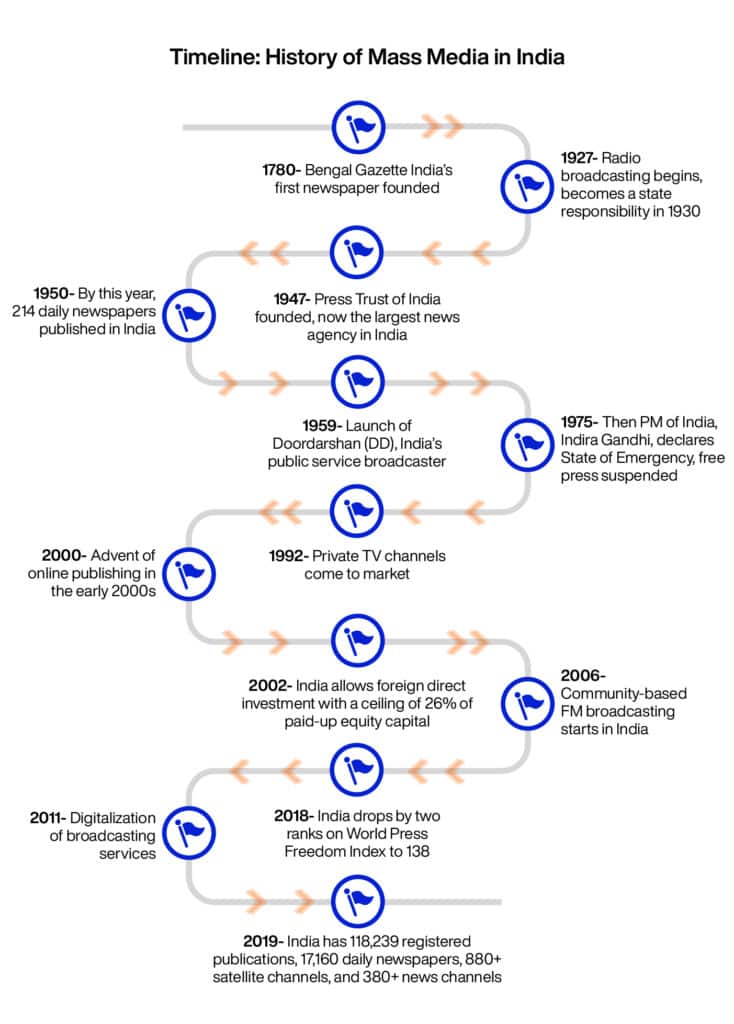Since the inception of the Bengal Gazette in 1780, Indian journalism has seen remarkable growth. Print media has expanded exponentially, with thousands of newspapers and magazines serving diverse interests. Technological advancements, notably in printing, have facilitated faster dissemination of information.
During the freedom struggle, newspapers like “The Hindu” and “Vande Mataram” played pivotal roles in rallying public opinion. The introduction of radio and television brought new dimensions to mass communication. The digital revolution has further transformed media consumption habits, with online platforms providing instant access to news. Despite challenges such as misinformation and declining revenues, digital media has opened avenues for citizen journalism and independent voices.
The future of digital journalism hinges on embracing innovation while upholding journalistic integrity and ethics. Let’s explore the journey of journalism and the promising future that lies ahead.
Timeline of the evolution of mass media
The evolution of mass media spans centuries. Each era, from the Industrial to the Digital Age, has seen transformative advancements, shaping how information is produced, distributed, and consumed.

Pre-Industrial Age (1041-1700)
Before the Industrial Age, communication primarily relied on oral tradition, handwritten manuscripts, and limited printing methods. Information dissemination was slow and localized, mainly through word of mouth or written documents transported by messengers or traders.
- In 1041, movable clay-type printing was invented in China, pioneering mass text production and setting the stage for broader information dissemination.
- In 1440, Johannes Gutenberg’s movable type printing press revolutionized printing, enabling the mass production of newspapers and pamphlets and laying the foundation for modern journalism.
- William Caxton’s publication of the first printed advertisement in a book in 1477 signaled the early commercialization of print media.
Also read: how to start a career in data journalism
Industrial Age (1700-1930)
The Industrial Age saw the emergence of mass production and mechanical printing technologies, leading to the proliferation of newspapers, magazines, and books. Communication became more widespread and accessible, enabling the dissemination of information on a larger scale.
- In 1774, George Louis Lesage’s electric telegraph enabled rapid communication over long distances, facilitating the transmission of news to newspapers.
- The typewriter, invented by W.S. Burt in 1829, revolutionized writing and editing and enhanced the efficiency of newspaper production.
- Alexander Graham Bell’s telephone, introduced in 1876, facilitated interviews and information gathering for journalists.
- Thomas Alva Edison’s phonograph, developed in 1877, allowed for audio recording, advancing audio journalism.
- Guglielmo Marconi’s radio, invented in 1894, enabled wireless transmission of audio signals, transforming news broadcasting.
- In 1918, the first color movie, “Cupid Angling,” was shot, enhancing visual storytelling.
- John Logie Baird’s invention of the television in 1920 and KDKA’s first radio commercial broadcast introduced new platforms for news dissemination.
You may also like Tips for establishing a successful career in broadcast journalism
Electronic Age (1930s to 1980s)
The Electronic Age marked the advent of electronic communication technologies. These innovations revolutionized how information was transmitted and consumed, significantly impacting mass media and shaping public discourse.
- The 1940s saw the emergence of Community Antenna Television systems, which laid the groundwork for cable television’s expanding news dissemination channels.
- In the 1950s, the advent of black and white TV brought news into people’s homes, democratizing information access and influencing public opinion.
- The rise of FM Radio in the 1960s provided another platform for news broadcasting, diversifying media consumption habits.
- The introduction of audio cassettes in 1963 facilitated audio recording, enriching storytelling capabilities for radio journalism.
- The development of email in 1972 by Ray Tomlinson revolutionized communication in newsrooms, enabling rapid information exchange among journalists and editors.
- The debut of the first handheld mobile phone in 1973 marked the beginning of mobile journalism, enabling reporters to capture and share news from the field.
- The introduction of VCRs in 1975 facilitated television news coverage and archival, enhancing storytelling through visual media.
- The 1980s witnessed the mainstream adoption of color television and the launch of the first online newspaper, Columbus Dispatch.
- The introduction of the IBM Personal Computer in 1981 and the launch of Microsoft Windows in 1985 revolutionized newsroom operations.
Evolution of New Media (21st Century)
The 21st Century witnessed a rapid evolution of new media, driven by advancements in digital technology and the internet. This has transformed how people access, consume, and interact with information, blurring the lines between producers and consumers of media content.
- Social networking sites transformed journalism in the age of social media. Platforms like Facebook (2004), YouTube (2005), Twitter (2006), and Tumblr (2007) provided new avenues for news reporting, audience engagement, and citizen journalism.
- Instant messaging services (2001) facilitated real-time communication among journalists and news organizations, enhancing collaboration and information exchange.
- The launch of satellite radio in 2002 expanded the reach of audio journalism.
- The rise of photo-sharing platforms like Instagram in 2010 further diversified digital storytelling techniques, enabling journalists to convey news stories through visual narratives.
You may like to know more about the impact of AI in the media industry.
Impact of technology on journalism
The impact of technology on journalism is profound, evident in digital journalism trends like real-time reporting and interactive storytelling. Journalism in the age of social media emphasizes audience engagement and citizen journalism. Digital storytelling techniques encompass multimedia formats, enhancing news presentation.
Journalism will continue to evolve in the years to come, driven by technological advancements and changing audience preferences. Journalists must adapt to remain relevant, navigating challenges like misinformation while leveraging opportunities for innovation and audience interaction. The fusion of technology and journalism will shape the future, influencing how news is produced, consumed, and shared.
You can also check How a degree in journalism would benefit in a fast-changing media scenario
Future of journalism
As the field of journalism evolves, several trends emerge, shaping the future of the industry:
- AI Integration: AI facilitates content creation and personalized news delivery, enhancing efficiency and relevance in journalism.
- Immersive Storytelling: Virtual reality (VR) and augmented reality (AR) technologies redefine news experiences, offering audiences immersive and interactive storytelling.
- Data Journalism Expansion: Journalists leverage big data for in-depth analysis and visualizations, providing deeper insights into complex issues.
- Blockchain Transparency: Blockchain technology ensures transparency and trust in news reporting, combating misinformation and fake news.
- Collaborative Journalism: Collaboration among journalists and news organizations enriches coverage of global events and complex issues, fostering diverse perspectives and comprehensive reporting.
- Subscription Models: Journalism increasingly relies on subscription-based revenue models, emphasizing reader support for financial sustainability and independence.
Take your journalism career forward with Online Manipal
Manipal University Jaipur (MUJ) offers a diverse range of undergraduate and postgraduate courses, including programs in journalism and mass communication. The courses are designed to provide students with comprehensive theoretical knowledge and practical skills in journalism, media studies, and communication. Special emphasis is placed on experiential learning, enabling students to develop critical thinking, communication, and storytelling abilities essential for success in the field of journalism. Additionally, MUJ’s state-of-the-art facilities and experienced faculty provide students with opportunities for holistic development and preparation for rewarding careers in journalism and media.
Conclusion
Technological advancements, from the printing press to the internet era, have shaped the evolution of journalism. Collaboration and ethical considerations are paramount. Looking ahead, journalism’s future lies in innovation, adaptability, and integrity. Embracing emerging technologies and evolving audience preferences will enable journalists to navigate the complexities of the digital age, providing trustworthy, immersive, and impactful news experiences for audiences worldwide.
Key Takeaways:
- Technology has revolutionized journalism, enabling real-time reporting and interactive storytelling.
- Journalism is poised for further evolution with AI integration, immersive storytelling using VR and AR, the expansion of data journalism, and the adoption of blockchain.
Prepare for your next career milestone with us







